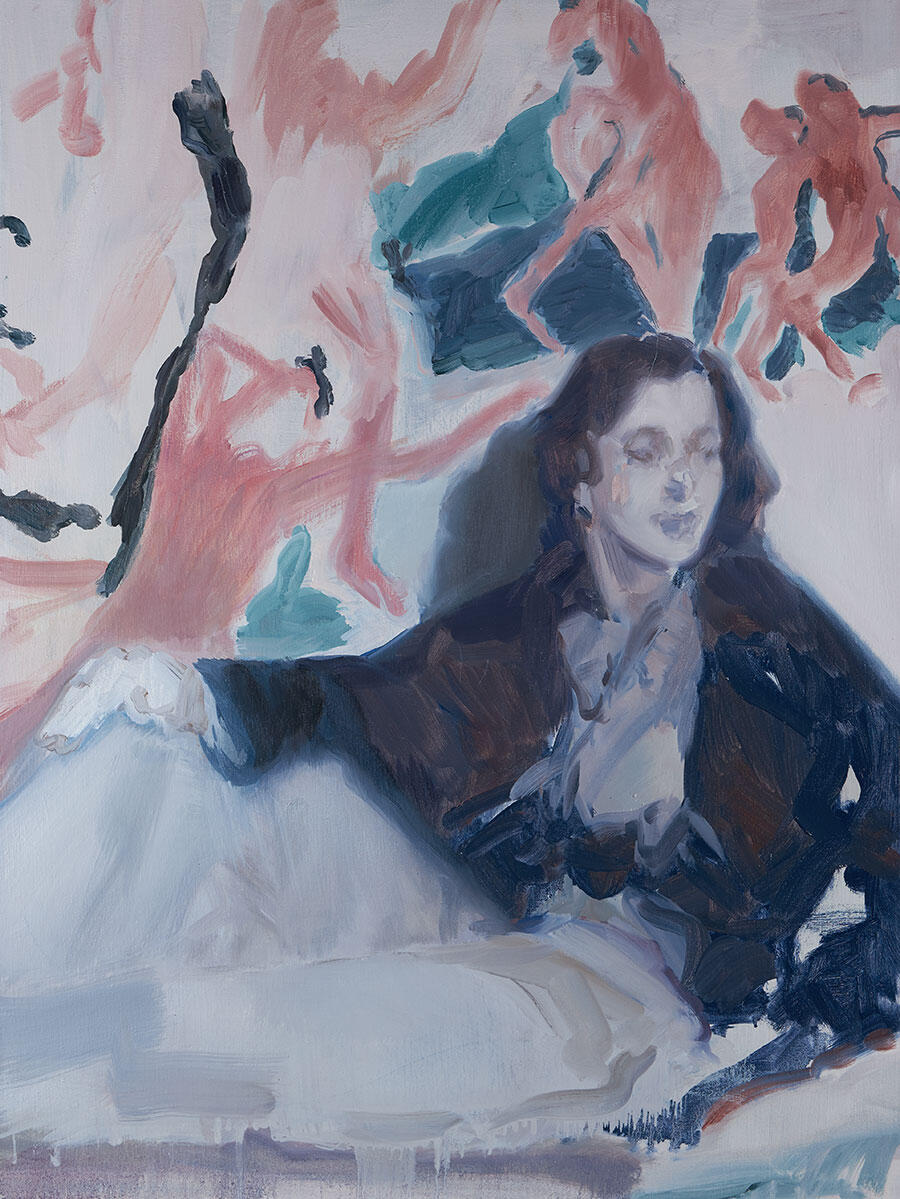Kaye Donachie Reimagines the Muse
At Pallant House Gallery, Chichester, the artist’s portraits play with the idea of cinematic dissolve to reframe female figures from history
At Pallant House Gallery, Chichester, the artist’s portraits play with the idea of cinematic dissolve to reframe female figures from history

Typically celebrated for their impact on artists, muses are often recognized for their physical appearance above all else. However, Kaye Donachie’s serene paintings of historical female protagonists reimagine the concept of the muse, with the artist aspiring less to an exact likeness than to a creative essence, often inspired by a single line of her subject’s writing.

In ‘Song for the Last Act’, Donachie’s portraits – flooded with chalky blues, purples and greys – hang on the sandy yellow walls of Pallant House Gallery in one of the 18th-century townhouse’s elegant ground-floor rooms, replete with stone fireplaces, wooden cladding and decorative moulding. The exhibition takes its name from the title of a 1949 poem by Louise Bogan – former US poet laureate – and plays with viewers’ sense of reality. Five new paintings are intended as interludes amongst the other works, playing with the idea of cinematic dissolve – the moment in filmmaking in which one scene blends to the next – which is central to Donachie’s practice. For example, To Echo (2023) depicts a close-up of a female face blending fluidly into a surrounding forest scape, while Notes Shift (2023) features a lounging woman surrounded by ghostly pink dancing figures.
Upstairs, in ‘Song for the Last Act: Chorus’, the conceptual undercurrents of the artist’s work really come into their own. Here, Donachie’s painting Monotonous Remorse (2019) is placed in conversation with a selection of 19th and 20th century works chosen by the artist from the gallery’s collection. Monotonous Remorse depicts the side profile of a woman inspired by the bohemian British poet and actress Iris Tree. Her hands rest on the back of a chair as she looks away from the viewer; it is unclear whether she is lost in a moment of thought or purposefully posing.

‘Song for the Last Act: Chorus’ must be entered via another exhibition, ‘Gwen John: Art and Life in London and Paris’ – a passage that would feel clumsy if the two didn’t have such rapport. John’s paintings also regularly feature female sitters and share affinities with Donachie’s soft, at times ethereal, palette. In ‘Chorus’, wallpaper photocopied from original drawings, enlarged, then painted in swirls and blocks of brown, grey and black provides the backdrop for some of the other artists’ works. The wallpaper’s numerous rectangular forms could be seen as doorways on a set, drawing on Donachie’s interest in staging and filmmaking.
Monotonous Remorse invites countless analogies with the surrounding works, from Paul Cézanne’s languid 19th-century Les Grands Baigneurs (The Large Bathers, 1898) to Jacqueline Morreau’s timeless charcoal drawing of a woman viewing her reflection (Woman and Mirror, c.1983). Moments of relaxation abound, punctured by surprising tensions. A small etching by Walter Sickert (Mon Bon Dodo, 1915), for instance, teeters between sleep and restlessness. The bed-like form that supports a recumbent figure could be viewed as a landscape, with tall trees for bedposts; the face could be in repose or contorted in sickness. This calls to mind Donachie’s fascination with dissolving scenes and the transitional states between wakefulness and sleep, dream and nightmare.

In contrast to the many nude and half-dressed figures depicted throughout the room, the artist’s inclusion of a handful of portraits of heavily adorned women – draped in fur, silk and pearls – highlights the theatricality of clothing. The luxurious fashion choices in Glyn Philpot’s Mrs. Clement Cross (1934) and Sickert’s Gwen Ffrangcon-Davies in ‘The Lady with a Lamp’ (1932–34) create moments of slippage that invest Donachie’s curatorial eye with intrigue. Capturing the inherent strangeness and disorder of the world, ‘Song for the Last Act’ presents a hazy fantasy within which we may try to find solid ground, or allow ourselves to be carried away.
Kaye Donachie’s ‘Song for the Last Act’ is at Pallant House Gallery, Chichester, until October 08, 2023
Main image: Kaye Donachie, To Echo (detail), 2023, oil on linen, 46 × 40 cm. Courtesy: © Kaye Donachie and Maureen Paley, London
























